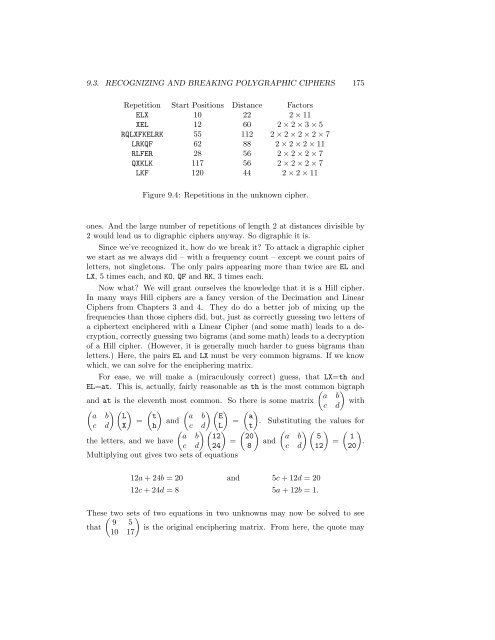Cryptology - Unofficial St. Mary's College of California Web Site
Cryptology - Unofficial St. Mary's College of California Web Site
Cryptology - Unofficial St. Mary's College of California Web Site
You also want an ePaper? Increase the reach of your titles
YUMPU automatically turns print PDFs into web optimized ePapers that Google loves.
9.3. RECOGNIZING AND BREAKING POLYGRAPHIC CIPHERS 175<br />
Repetition <strong>St</strong>art Positions Distance Factors<br />
ELX 10 22 2 × 11<br />
XEL 12 60 2 × 2 × 3 × 5<br />
RQLXFKELRK 55 112 2 × 2 × 2 × 2 × 7<br />
LRKQF 62 88 2 × 2 × 2 × 11<br />
RLFER 28 56 2 × 2 × 2 × 7<br />
QXKLK 117 56 2 × 2 × 2 × 7<br />
LKF 120 44 2 × 2 × 11<br />
Figure 9.4: Repetitions in the unknown cipher.<br />
ones. And the large number <strong>of</strong> repetitions <strong>of</strong> length 2 at distances divisible by<br />
2 would lead us to digraphic ciphers anyway. So digraphic it is.<br />
Since we’ve recognized it, how do we break it To attack a digraphic cipher<br />
we start as we always did – with a frequency count – except we count pairs <strong>of</strong><br />
letters, not singletons. The only pairs appearing more than twice are EL and<br />
LX, 5 times each, and KO, QF and RK, 3 times each.<br />
Now what We will grant ourselves the knowledge that it is a Hill cipher.<br />
In many ways Hill ciphers are a fancy version <strong>of</strong> the Decimation and Linear<br />
Ciphers from Chapters 3 and 4. They do do a better job <strong>of</strong> mixing up the<br />
frequencies than those ciphers did, but, just as correctly guessing two letters <strong>of</strong><br />
a ciphertext enciphered with a Linear Cipher (and some math) leads to a decryption,<br />
correctly guessing two bigrams (and some math) leads to a decryption<br />
<strong>of</strong> a Hill cipher. (However, it is generally much harder to guess bigrams than<br />
letters.) Here, the pairs EL and LX must be very common bigrams. If we know<br />
which, we can solve for the enciphering matrix.<br />
For ease, we will make a (miraculously correct) guess, that LX=th and<br />
EL=at. This is, actually, fairly reasonable as th is the most common ( bigraph ) a b<br />
and at is the eleventh most common. So there is some matrix with<br />
c d<br />
( ( ) ( ( ( ) ( a b L t a b E a<br />
= and<br />
= . Substituting the values for<br />
c d)<br />
X h)<br />
c d)<br />
L t)<br />
( ) ( ) ( ) ( ( ) ( a b 12 20 a b 5 1<br />
the letters, and we have<br />
= and<br />
= .<br />
c d 24 8 c d)<br />
12 20)<br />
Multiplying out gives two sets <strong>of</strong> equations<br />
12a + 24b = 20 and 5c + 12d = 20<br />
12c + 24d = 8 5a + 12b = 1.<br />
These( two sets ) <strong>of</strong> two equations in two unknowns may now be solved to see<br />
9 5<br />
that<br />
is the original enciphering matrix. From here, the quote may<br />
10 17

















